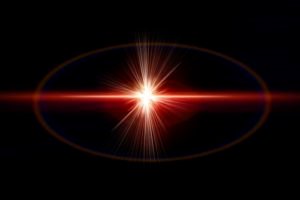The Human Eye Could Help Test Quantum Mechanics


Photon
Paul Kwiat asks his volunteers to sit inside a small, dark room. As their eyes adjust to the lack of light, each volunteer props his or her head on a chin rest—as you would at an optometrist’s—and gazes with one eye at a dim red cross. On either side of the cross is an optical fiber, positioned to pipe a single photon of light at either the left or the right side of a volunteer’s eye.
Even as he verifies the human eye’s ability to detect single photons, Kwiat, an experimental quantum physicist at the University of Illinois at Urbana–Champaign, and his colleagues are setting their sights higher: to use human vision to probe the very foundations of quantum mechanics, according to a paper they submitted to the preprint server arXiv on June 21.
Rather than simply sending single photons toward a volunteer’s eye through either the left or the right fiber, the idea is to send photons in a quantum superposition of effectively traversing both fibers at once. Will humans see any difference? According to standard quantum mechanics, they will not—but such a test has never been done. If Kwiat’s team produces conclusive results showing otherwise, it would question our current understanding of the quantum world, opening the door to alternative theories that argue for a dramatically different view of nature in which reality exists regardless of observations or observers, cutting against the grain of how quantum mechanics is interpreted today. “It could possibly be evidence that something’s going on beyond standard quantum mechanics,” says Rebecca Holmes, Kwiat’s former student who designed the equipment, and who is now a researcher at the Los Alamos National Laboratory.
The effort to determine whether humans can directly detect single photons has a storied history. In 1941 researchers from Columbia University reported in Science the human eye can see a flash from as few as five photons landing on the retina. More than three decades later Barbara Sakitt, a biophysicist then at the University of California, Berkeley, performed experiments suggesting that the eye could see a single photon. But these experiments were far from conclusive. “The problem with all these experiments is that they were just trying to use ‘classical’ light sources” that do not reliably emit single photons, Holmes says. That is, there was no guarantee each of these early trials involved just one photon.

Frog eye
Then, in 2012, came firm evidence that individual photoreceptors, or rod cells, can detect single photons—at least in the eyes of a frog. Leonid Krivitsky of the Agency for Science, Technology and Research in Singapore and his colleagues extracted rod cells from adult frogs’ eyes and performed laboratory tests showing the cells reacted to single photons. Now, “there’s absolutely no doubt that individual photoreceptors respond to single photons,” Kwiat says. That is not the same as saying those rod cells do the same in a living frog—or, for that matter, a human being. So Kwiat, along with Illinois colleague physicist Anthony Leggett and others, began envisioning tests of human vision using single-photon sources. Soon Kwiat’s group, which now included Holmes, was actually experimenting. But “we got beat on that,” Holmes says.
[button color="white" size="normal" alignment="center" rel="follow" openin="newwindow" url="https://www.scientificamerican.com/article/the-human-eye-could-help-test-quantum-mechanics/"]Continue To Read[/button]